A Sight to See - Precast concrete enhances the beauty of the Academy Museum of Motion Pictures
Mark Crawford
It will soon be one of the most eye-catching structures in the country. The 300,000-square-foot Academy Museum of Motion Pictures, dedicated to the art and science of the film industry, will open in late 2019 in Los Angeles. Designed by Renzo Piano, founder of the Renzo Piano Building Workshop, the museum will feature 50,000 square feet of galleries, exhibits and theaters.
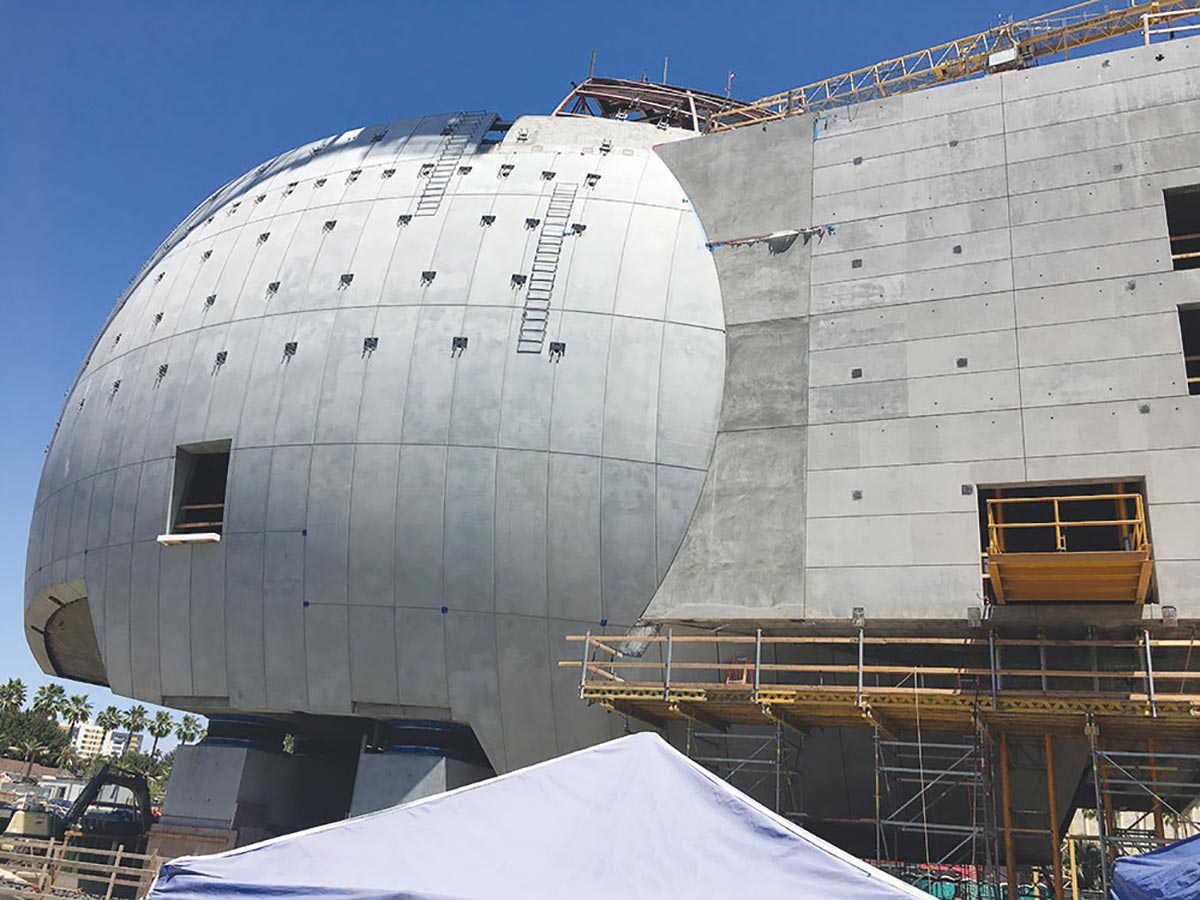 Photo courtesy of Robert Whitmore The new Academy Museum of Motion Pictures is slated to open in 2019, and precast concrete gives the building a sharp, clean look.
Photo courtesy of Robert Whitmore The new Academy Museum of Motion Pictures is slated to open in 2019, and precast concrete gives the building a sharp, clean look.
Perhaps the most impressive part of the project is the Sphere Building, which includes a 1,000-square-foot theater and a spectacular, glass-domed terrace overlooking the famed Hollywood Hills. The bottom half of this globe-shaped building consists of structural concrete with a decorative cladding of precast concrete panels, giving it a stylish, finished exterior that will draw visitors inside to see more.
A perfect precast solution
The original architectural proposal for the Sphere focused on a steel structure clad with metal panels. This design relied on steel trusses spanning across the theater, each supported by curved columns just inside the spherical walls. However, because the required truss depths blocked the projection lines inside the theater, the design team decided to change the structure to a shallow concrete dome, which eliminated the problem of the trusses. There was some concern, however, that using cast-in-place concrete would not create the smooth, clean, natural finish that Piano envisioned. Thus, the team decided to use precast concrete panels to provide the fine details and sharp lines they envisioned.
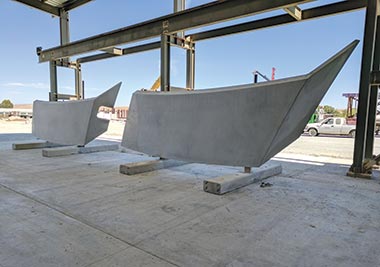 Photo courtesy of Willis Construction Curved precast concrete panels serve as the skin of the Sphere.
The shape of the museum theater is a sphere cut by intersecting planes. The jointing on the sphere has parallel slices east/west and north/south, similar to an egg slicer. As a result, the shapes become more skewed the farther they get from the sphere midline.
Photo courtesy of Willis Construction Curved precast concrete panels serve as the skin of the Sphere.
The shape of the museum theater is a sphere cut by intersecting planes. The jointing on the sphere has parallel slices east/west and north/south, similar to an egg slicer. As a result, the shapes become more skewed the farther they get from the sphere midline.
"Using precast concrete allows us to maintain the precision and crispness of the joint pattern and the sphere geometry, and also ensure a high-quality, consistent as-cast finish," said Mark Hildebrand, president and chief engineer for Willis Construction Co. in San Juan Bautista, Calif., which provided the precast concrete for the project.
The precast panels serve as the skin of the Sphere and function as the permanent formwork to support the structural concrete during placement operations.
"In other words, the architectural finish was installed before the structure was built," said Hildebrand. "This required a steel structure upon which to erect the precast panels."
A system of steel frames was constructed to support the Sphere's 1- to 2-ton precast panels. Workers hung the curved panels on the steel frames, then sprayed shotcrete against the back of the panels.
"This allowed eliminating the trusses, but required continuous support around the perimeter in lieu of the discreet columns, which led to the use of continuous shotcrete walls," said Derrick Roorda, principal with BuroHappold Engineering, one of the contractors on the project. "The architects felt strongly that the shotcrete would need precast cladding in order to guarantee a suitable finish. Cost considerations led to the idea of erecting the precast first and using it as formwork for the shotcrete primary structure."
Greg Wade, project manager for MATT Construction Corporation and general manager for the project, said they have used shotcrete and precast, but they've never combined the two.
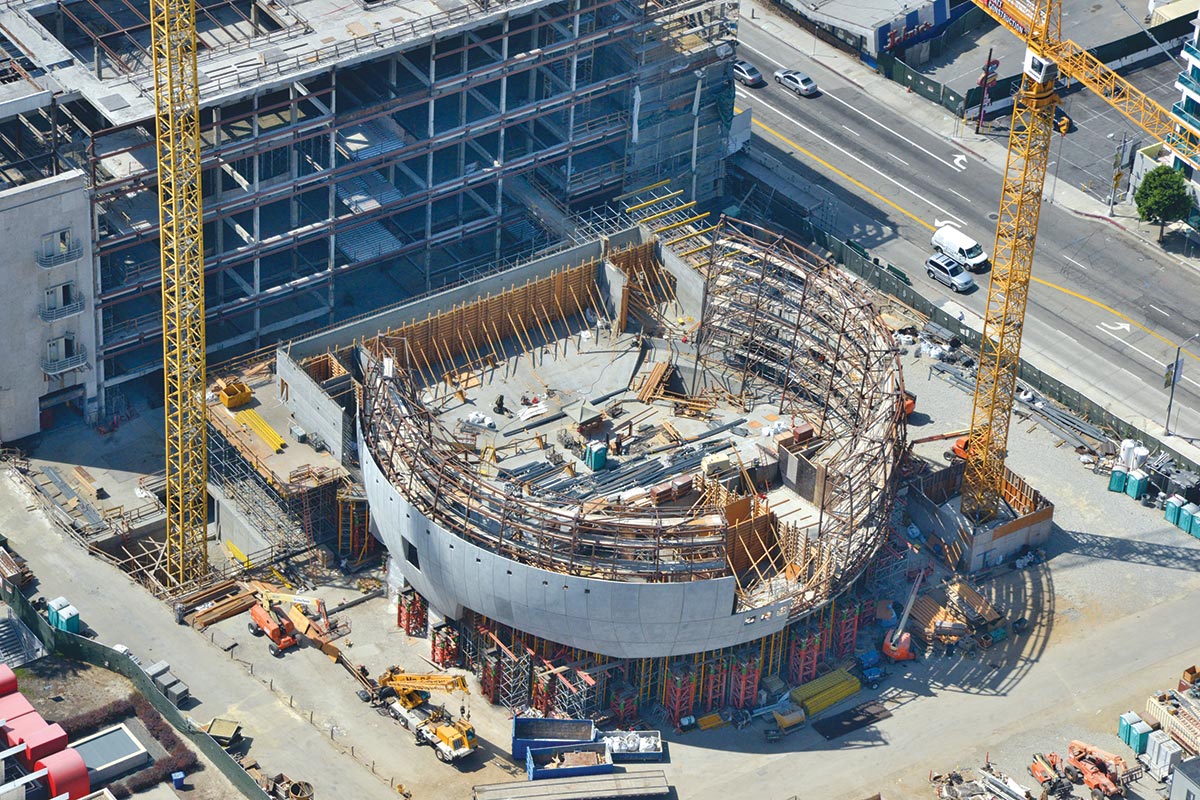 Photo courtesy of Buro Happold Engineering
Photo courtesy of Buro Happold Engineering
More than 727 precast concrete components come together to make the Sphere building.
A complex design process
The complex sequencing demanded that many architectural details for the precast finish needed to be worked out and incorporated into the structural design process. All the coordination was completed with the aid of computer models.
"The architect, structural engineer and precast manufacturer each developed models for their own scope and we had weekly discussions to resolve problems and talk about upcoming issues," said Hildebrand. "As other trades came on board, their models were developed, discussed and incorporated as well."
Once the precast model was complete and approved, molds were fabricated and shop tickets drawn directly from the model.
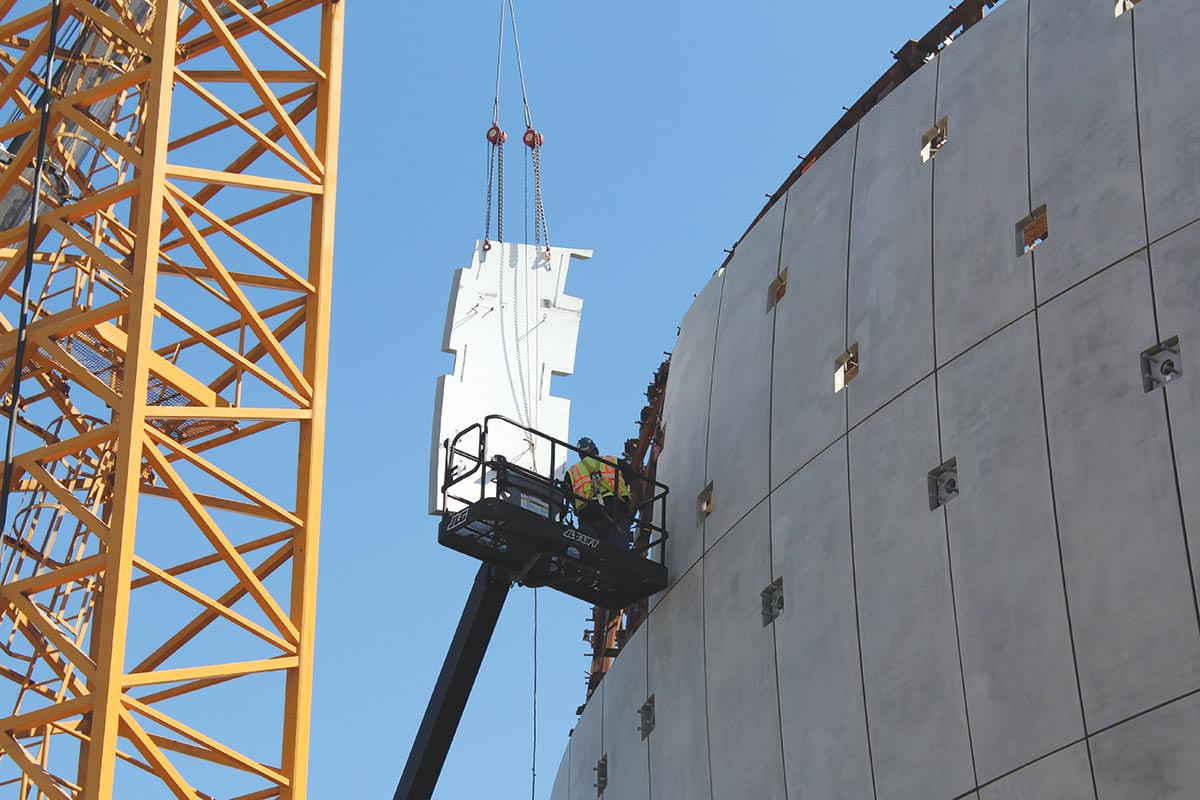 Photo courtesy of Willis Construction Curved precast concrete panels create an eye-catching building that will house the Academy Museum of Motion Pictures in Los Angeles.
Photo courtesy of Willis Construction Curved precast concrete panels create an eye-catching building that will house the Academy Museum of Motion Pictures in Los Angeles.
Unique precast panels
The precast panels are double-curved with non-orthogonal returns.
"Precast gave us the possibility to control the shape to tighter tolerances," said Luigi Priano, an associate, with Renzo Piano Building Workshop. "It took a long period of research to find the optimal mix to achieve the proper crispness, color and texture. In addition, the craftsmanship of the precast manufacturer greatly helped to control the consistency of the finish."
The Sphere required 727 precast components with 578 unique shapes, many of them one of a kind. The 4-inch-thick panels include welded wire fabric reinforcements cast with 7,000-psi concrete.
A huge challenge was giving the mold crew enough information on a 2D shop drawing to build the 3D mold and maintain tight tolerances. The digital model also included all the penetrations in the panels for attaching the glass canopy at the top of the structure, to ensure their exact location on the face of the sphere.
Most of the shapes have no square corners or edges so the typical techniques for layout and alignment in the field did not apply.
"Also, during erection, there were no layout lines on the structure because the structure wasn't there yet," said Hildebrand. "Each panel was tagged with four points that corresponded to specific coordinates of the project's global coordinate system. The panels were then set and aligned with positions verified by the surveyor."
The Willis team programmed its computer numerically controlled (CNC) router machine to carve whole molds or mold parts directly from the 3D computer files of the design model. One of the challenges in using this technology in combination with traditional molding techniques is creating all the panel shapes needed from the fewest number of base molds.
"We used the CNC to carve 30 base molds from which we could fabricate the 578 different shapes using shut-offs and other mold parts built up off the base," said Hildebrand. "Because the base molds are segments of a sphere, there are no 90-degree angles. The carpenters in the mold shop can't just 'square it up' in the traditional way.
"The shop drawings have lots of dimensions so that components added on to the base mold can be triangulated into position with some degree of certainty."
Close coordination between the mold crew and the detailing crew (who are translating the 3D computer shapes into paper drawings) was required to come up with the dimensions that are most useful and effective.
"If necessary, we can also model into the computer setting jigs for getting the right angles or skews and then carve those on the CNC machine as construction aids to the carpenters," said Hildebrand.
A grand 2019 opening
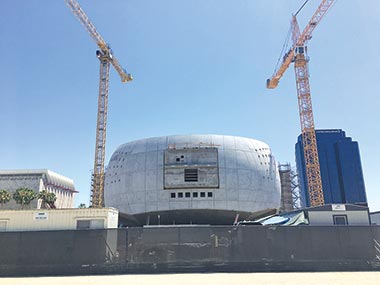 Photo courtesy of Robert Whitmore
Precast panel work on the Sphere Building is in progress with the panels still needing blind connections to cover the top and bottom of the Sphere. Once the panels are in place, a ring beam around the top of the sphere will be installed and covered with concrete deck to tie the structure together to add strength and rigidity.
Photo courtesy of Robert Whitmore
Precast panel work on the Sphere Building is in progress with the panels still needing blind connections to cover the top and bottom of the Sphere. Once the panels are in place, a ring beam around the top of the sphere will be installed and covered with concrete deck to tie the structure together to add strength and rigidity.
This one-of-a-kind project integrates both the structural and architectural benefits of precast concrete to create bold shapes, graceful lines and eye-catching colors and features. Hildebrand eagerly admits he likes the many challenges on this project, such as using precast as permanent formwork.
"We even put strain gauges on the connections for the mockup and tracked the forces over time as the different lifts of shotcrete were applied," he said. "This gave us confidence in the ability of our panels and connections to take the strain of the concrete-placing operations in the field, as any failure would have been catastrophic."
Hildebrand also can't stress enough the importance of communication, collaboration and teamwork for such a complex project.
"We successfully modeled a complicated structure with all of the different trades involved and then built to the model, with no layout lines," Hildebrand said. "Also key to all this is having a good surveyor and having all trades use the same surveying team. The coordination between all the team members, and the vetting process of different ideas, was essential for getting to the finish line."
Mark Crawford is a Madison, Wis.-based freelance writer who specializes in science, technology and manufacturing.
Acknowledgement: The article has been reprinted/reproduced from National Precast Concrete Association (http://precast.org/) with its due permission.
It will soon be one of the most eye-catching structures in the country. The 300,000-square-foot Academy Museum of Motion Pictures, dedicated to the art and science of the film industry, will open in late 2019 in Los Angeles. Designed by Renzo Piano, founder of the Renzo Piano Building Workshop, the museum will feature 50,000 square feet of galleries, exhibits and theaters.
 Photo courtesy of Robert Whitmore The new Academy Museum of Motion Pictures is slated to open in 2019, and precast concrete gives the building a sharp, clean look.
Photo courtesy of Robert Whitmore The new Academy Museum of Motion Pictures is slated to open in 2019, and precast concrete gives the building a sharp, clean look.Perhaps the most impressive part of the project is the Sphere Building, which includes a 1,000-square-foot theater and a spectacular, glass-domed terrace overlooking the famed Hollywood Hills. The bottom half of this globe-shaped building consists of structural concrete with a decorative cladding of precast concrete panels, giving it a stylish, finished exterior that will draw visitors inside to see more.
A perfect precast solution
The original architectural proposal for the Sphere focused on a steel structure clad with metal panels. This design relied on steel trusses spanning across the theater, each supported by curved columns just inside the spherical walls. However, because the required truss depths blocked the projection lines inside the theater, the design team decided to change the structure to a shallow concrete dome, which eliminated the problem of the trusses. There was some concern, however, that using cast-in-place concrete would not create the smooth, clean, natural finish that Piano envisioned. Thus, the team decided to use precast concrete panels to provide the fine details and sharp lines they envisioned.
 Photo courtesy of Willis Construction Curved precast concrete panels serve as the skin of the Sphere.
Photo courtesy of Willis Construction Curved precast concrete panels serve as the skin of the Sphere."Using precast concrete allows us to maintain the precision and crispness of the joint pattern and the sphere geometry, and also ensure a high-quality, consistent as-cast finish," said Mark Hildebrand, president and chief engineer for Willis Construction Co. in San Juan Bautista, Calif., which provided the precast concrete for the project.
The precast panels serve as the skin of the Sphere and function as the permanent formwork to support the structural concrete during placement operations.
"In other words, the architectural finish was installed before the structure was built," said Hildebrand. "This required a steel structure upon which to erect the precast panels."
A system of steel frames was constructed to support the Sphere's 1- to 2-ton precast panels. Workers hung the curved panels on the steel frames, then sprayed shotcrete against the back of the panels.
"This allowed eliminating the trusses, but required continuous support around the perimeter in lieu of the discreet columns, which led to the use of continuous shotcrete walls," said Derrick Roorda, principal with BuroHappold Engineering, one of the contractors on the project. "The architects felt strongly that the shotcrete would need precast cladding in order to guarantee a suitable finish. Cost considerations led to the idea of erecting the precast first and using it as formwork for the shotcrete primary structure."
Greg Wade, project manager for MATT Construction Corporation and general manager for the project, said they have used shotcrete and precast, but they've never combined the two.
 Photo courtesy of Buro Happold Engineering
Photo courtesy of Buro Happold EngineeringMore than 727 precast concrete components come together to make the Sphere building.
The complex sequencing demanded that many architectural details for the precast finish needed to be worked out and incorporated into the structural design process. All the coordination was completed with the aid of computer models.
"The architect, structural engineer and precast manufacturer each developed models for their own scope and we had weekly discussions to resolve problems and talk about upcoming issues," said Hildebrand. "As other trades came on board, their models were developed, discussed and incorporated as well."
Once the precast model was complete and approved, molds were fabricated and shop tickets drawn directly from the model.
 Photo courtesy of Willis Construction Curved precast concrete panels create an eye-catching building that will house the Academy Museum of Motion Pictures in Los Angeles.
Photo courtesy of Willis Construction Curved precast concrete panels create an eye-catching building that will house the Academy Museum of Motion Pictures in Los Angeles.Unique precast panels
The precast panels are double-curved with non-orthogonal returns.
"Precast gave us the possibility to control the shape to tighter tolerances," said Luigi Priano, an associate, with Renzo Piano Building Workshop. "It took a long period of research to find the optimal mix to achieve the proper crispness, color and texture. In addition, the craftsmanship of the precast manufacturer greatly helped to control the consistency of the finish."
The Sphere required 727 precast components with 578 unique shapes, many of them one of a kind. The 4-inch-thick panels include welded wire fabric reinforcements cast with 7,000-psi concrete.
A huge challenge was giving the mold crew enough information on a 2D shop drawing to build the 3D mold and maintain tight tolerances. The digital model also included all the penetrations in the panels for attaching the glass canopy at the top of the structure, to ensure their exact location on the face of the sphere.
Most of the shapes have no square corners or edges so the typical techniques for layout and alignment in the field did not apply.
"Also, during erection, there were no layout lines on the structure because the structure wasn't there yet," said Hildebrand. "Each panel was tagged with four points that corresponded to specific coordinates of the project's global coordinate system. The panels were then set and aligned with positions verified by the surveyor."
The Willis team programmed its computer numerically controlled (CNC) router machine to carve whole molds or mold parts directly from the 3D computer files of the design model. One of the challenges in using this technology in combination with traditional molding techniques is creating all the panel shapes needed from the fewest number of base molds.
"We used the CNC to carve 30 base molds from which we could fabricate the 578 different shapes using shut-offs and other mold parts built up off the base," said Hildebrand. "Because the base molds are segments of a sphere, there are no 90-degree angles. The carpenters in the mold shop can't just 'square it up' in the traditional way.
"The shop drawings have lots of dimensions so that components added on to the base mold can be triangulated into position with some degree of certainty."
Close coordination between the mold crew and the detailing crew (who are translating the 3D computer shapes into paper drawings) was required to come up with the dimensions that are most useful and effective.
"If necessary, we can also model into the computer setting jigs for getting the right angles or skews and then carve those on the CNC machine as construction aids to the carpenters," said Hildebrand.
A grand 2019 opening
 Photo courtesy of Robert Whitmore
Photo courtesy of Robert WhitmoreThis one-of-a-kind project integrates both the structural and architectural benefits of precast concrete to create bold shapes, graceful lines and eye-catching colors and features. Hildebrand eagerly admits he likes the many challenges on this project, such as using precast as permanent formwork.
"We even put strain gauges on the connections for the mockup and tracked the forces over time as the different lifts of shotcrete were applied," he said. "This gave us confidence in the ability of our panels and connections to take the strain of the concrete-placing operations in the field, as any failure would have been catastrophic."
Hildebrand also can't stress enough the importance of communication, collaboration and teamwork for such a complex project.
"We successfully modeled a complicated structure with all of the different trades involved and then built to the model, with no layout lines," Hildebrand said. "Also key to all this is having a good surveyor and having all trades use the same surveying team. The coordination between all the team members, and the vetting process of different ideas, was essential for getting to the finish line."
Mark Crawford is a Madison, Wis.-based freelance writer who specializes in science, technology and manufacturing.
Acknowledgement: The article has been reprinted/reproduced from National Precast Concrete Association (http://precast.org/) with its due permission.
NBM&CW May 2019



















